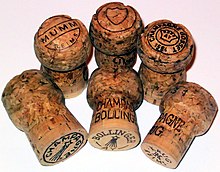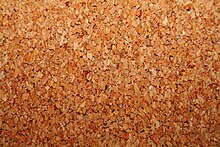Cork (material)





Cork material is a subset of generic cork tissue, harvested for commercial use primarily from the Cork Oak tree, Quercus suber, with Portugal producing 50% of cork worldwide.[1] Cork consists mostly of suberin. Cork's elasticity combined with its near-impermeability makes it suitable as a material for bottle stoppers, especially for wine bottles. Cork stoppers represent about 60% of all cork based production. Cork's low density makes it a suitable material for fishing floats and buoys, as well as handles for fishing rods (as an alternative to neoprene). Cork is used in musical instruments, particularly woodwind instruments, where it is used to fasten together segments of the instrument, making the seams airtight. Sheets of cork, often the by-product of more lucrative stopper production, are used to make floor tiles and bulletin boards. Granules of cork can also be mixed into concrete. The composites made by mixing cork granules and cement have low thermal conductivity, low density and good energy absorption. Some of the property ranges of the composites are density (400–1500 kg/m³), compressive strength (1–26 MPa) and flexural strength (0.5–4.0 MPa).[2]
The cork industry is generally regarded as environmentally friendly. The sustainability of production and the easy recycling of cork products and by-products are two of its most distinctive aspects. However, only one leading company, Oeneo Bouchage of France has conducted and released its complete carbon footprint study, the first in the industry.
Cork demand has increased due to more wine being sealed with cork rather than being sold in bulk. Since a tree's bark can only be harvested six to nine years hence, supply is highly inelastic. Top quality corks are expensive, and no matter what the cost, have the risk of containing TCA Cork taint and are susceptible to random oxydation due to their mechanical variablility. Many cheaper brands have switched to lower quality cork, synthetic plastic stoppers, screwcaps, or other closures. Because synthetic stoppers do not dry out and shrink, wine bottles with synthetic corks do not have to be stored on their sides to prevent oxidizing However, plastic "cork" can create other wine problems, notably what is called scalping where flavors are actually absorbed into the plastic making the wine less flavorful. Cork contamination with harmless but foul-smelling trichloroanisole (TCA) is one of the primary causes of cork taint in wine.
As late as the mid 1600s, French vintners did not use cork stoppers, using oil-soaked rags stuffed into the necks of bottles instead.[3]
Cork has been used in rocket technology due to its fire resistance. Cork can be used as bricks for the outer walls of houses, as in Portugal's pavilion at Expo 2000. On November 28, 2007, the Portuguese national postal service CTT issued the world's first postage stamp made of cork.[4][5]
The Cork Oak is unrelated to the "cork trees" (Phellodendron), which have corky bark but are not used for cork production.
Cork was used by Robert Hooke as he discovered and named the cell.
See also
- Alternative wine closures
- APCOR, Portuguese Cork Association
- Cork cambium
- Cork borer
- Corkscrew
- Cork Boat (vessel)
Sources
- Cork Information pressedforwine.com
- Cork production corkfacts.com
- Instituto de Promoción del Corcho, Extremadura iprocor.org Template:Es icon
- Footnotes
- ^ pressedforwine.com Corks for Wine Bottles
- ^ Karade SR. 2003. An Investigation of Cork Cement Composites. PhD Thesis. BCUC. Brunel University, UK.
- ^ Prlewe, J. Wine From Grape to Glass. New York: Abbeville Press, 1999, p. 110.
- ^ Publico.pt Cork stamp almost sold out Template:Pt icon
- ^ IOL-A Step Beyond Cork stamp debuts in Portugal
